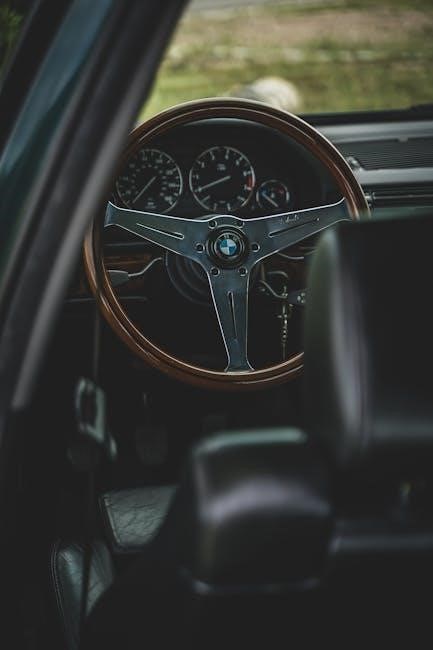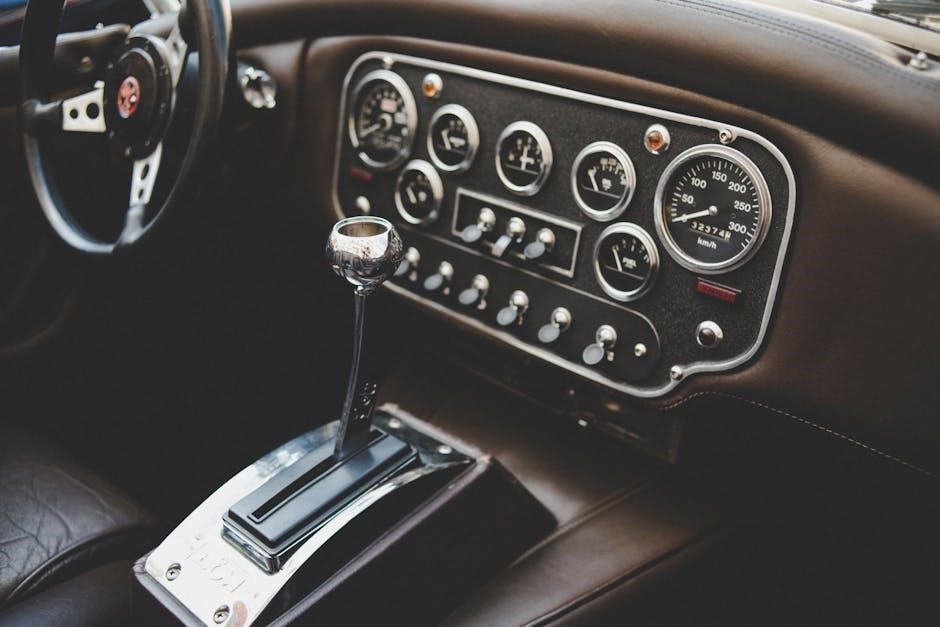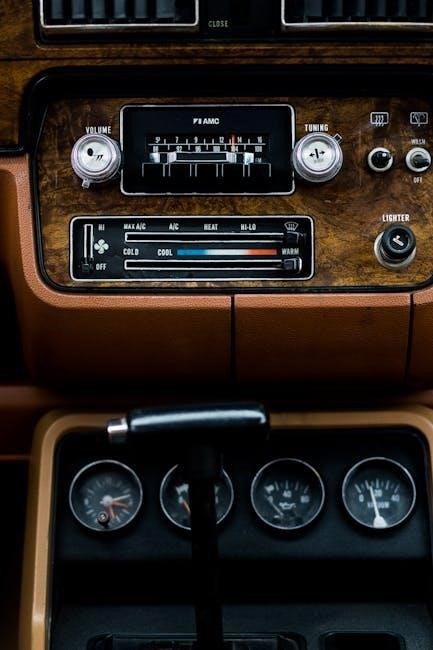The three-speed manual transmission is a foundational gear system offering mechanical simplicity and driver engagement‚ historically significant in automotive development and user interaction via clutch and gear shifting․
Overview of Three-Speed Manual Transmission
A three-speed manual transmission is a simple‚ non-automatic gearbox designed to transfer power from the engine to the wheels through three forward gear ratios․ It operates via a driver-controlled clutch pedal and a gearshift‚ allowing manual selection of gears to optimize speed and torque․ This system is mechanically straightforward‚ with fewer components compared to modern transmissions‚ making it lightweight and cost-effective․ Historically‚ it was a stepping stone in automotive development‚ offering better control and fuel efficiency than earlier systems․ While largely replaced by modern multi-speed transmissions‚ the three-speed remains iconic in classic vehicles‚ symbolizing a connection between driver and machine․ Its simplicity and nostalgic appeal continue to attract enthusiasts․
Key Components of a Three-Speed Manual Transmission
The three-speed manual transmission consists of several essential components that enable its operation․ The gear train includes three forward gears and one reverse gear‚ mounted on the main shaft and countershaft; The synchronizer rings facilitate smooth gear engagement by aligning gear speeds․ The clutch assembly connects and disconnects the engine from the transmission‚ allowing manual shifting․ The gearshift and linkage system translate driver input into gear changes․ The transmission housing encases all internal components‚ providing structural integrity․ Additionally‚ bearings and seals ensure proper lubrication and prevent wear․ These components work together to provide a reliable and straightforward gear-shifting experience‚ making the three-speed transmission both durable and user-friendly․
Significance of Three-Speed Manual Transmission in Automotive History
The three-speed manual transmission played a pivotal role in shaping automotive history‚ offering a balance of simplicity and functionality that made vehicles more accessible to the masses․ Introduced in the early 20th century‚ it revolutionized driver interaction by providing a user-friendly yet mechanically robust system․ Its widespread adoption in affordable vehicles like the Ford Model T democratized car ownership‚ making manual transmissions a cornerstone of automotive design․ This transmission type also laid the groundwork for more complex gear systems‚ influencing the development of modern manual transmissions․ Its enduring popularity in classic cars highlights its historical significance and nostalgic appeal‚ cementing its place as a foundational element in automotive evolution․

History and Evolution
The three-speed manual transmission emerged in the early 20th century‚ evolving from basic two-speed systems․ It became a standard in vehicles‚ influencing the development of modern manual transmissions over time․
Development of the First Three-Speed Manual Transmissions
The first three-speed manual transmissions were developed in the early 20th century‚ marking a significant innovation in automotive engineering․ These systems were designed to provide better control and efficiency compared to earlier two-speed models․ By incorporating a manual gear-shifting mechanism and a clutch‚ drivers could transition between gears more effectively‚ enhancing overall vehicle performance․ The initial three-speed transmissions were relatively simple in design‚ focusing on durability and reliability for everyday use․ They quickly became a standard feature in many early vehicles‚ paving the way for more complex manual transmission systems in the future․ This development played a crucial role in shaping the automotive industry’s progress․
Rise of Three-Speed Manual Transmissions in the Early 20th Century
The early 20th century saw the widespread adoption of three-speed manual transmissions in vehicles‚ becoming a standard feature due to their simplicity and cost-effectiveness․ As automotive technology advanced‚ these transmissions offered improved drivability compared to earlier systems․ The Ford Model T‚ introduced in 1908‚ popularized the three-speed manual transmission‚ making it accessible to the masses․ This era marked a shift toward more efficient and user-friendly designs‚ with synchronization and improved gear ratios enhancing performance․ The rise of three-speed manuals coincided with the growth of the automotive industry‚ as they provided a reliable and affordable solution for drivers․ This period solidified the three-speed manual transmission’s place in automotive history‚ driving innovation and accessibility for decades to come․
Decline of Three-Speed Manual Transmissions in Modern Vehicles
The three-speed manual transmission has largely fallen out of favor in modern vehicles due to advancements in automotive technology and shifting consumer preferences․ Contemporary vehicles prioritize efficiency‚ smooth power delivery‚ and ease of use‚ which manual transmissions with more gear ratios better provide․ The rise of automatic and continuously variable transmissions (CVTs) has further diminished the need for three-speed manuals․ Additionally‚ stricter emissions and fuel efficiency standards have made older transmission designs less viable․ Modern drivers often prefer the convenience and seamless performance of automatics‚ leading manufacturers to phase out three-speed manuals in favor of more advanced systems․ This shift reflects broader industry trends toward innovation and driver comfort․

Modern Relevance and Nostalgia for Three-Speed Manual Transmissions
Despite their decline‚ three-speed manual transmissions hold a special place in automotive culture‚ evoking nostalgia for simpler‚ more mechanical driving experiences․ Enthusiasts often appreciate their direct engagement and historical significance․ In modern times‚ these transmissions are rarely used in new vehicles but remain popular in classic cars and restoration projects․ Some drivers and collectors seek out three-speed manuals for their durability and ease of maintenance․ While they lack the sophistication of modern gearboxes‚ they embody a bygone era of automotive innovation․ This nostalgia has created a dedicated community of enthusiasts who cherish the uniqueness of three-speed manuals‚ even as the industry moves toward more advanced transmission systems․

How It Works
The three-speed manual transmission operates through a clutch and gear system‚ allowing drivers to manually shift between gears using a shifter‚ engaging specific ratios for speed and torque․
Basic Principles of Gear Shifting in a Three-Speed Manual Transmission
The three-speed manual transmission functions by enabling drivers to manually select gear ratios using a clutch pedal and gearshift․ The clutch disengages the engine from the transmission‚ allowing smooth gear transitions․ Pressing the clutch pedal frees the engine‚ letting the driver shift gears without grinding․ Synchronizers within the transmission ensure gears mesh properly‚ reducing wear and noise․ As the driver moves the gearshift through the gate‚ the selected gear engages‚ providing the optimal speed and torque for driving conditions․ This mechanical process requires coordination between the clutch‚ accelerator‚ and gearshift‚ making it a hands-on driving experience that emphasizes control and precision․ Proper timing and technique are essential for seamless shifting․
Role of the Clutch in a Three-Speed Manual Transmission
The clutch plays a critical role in a three-speed manual transmission by disconnecting the engine from the transmission‚ allowing smooth gear shifts․ When the clutch pedal is pressed‚ it disengages the engine’s power‚ enabling the driver to shift gears without grinding․ The clutch consists of a friction plate that engages with the flywheel when the pedal is released․ Proper clutch operation requires gradual and controlled release to avoid jerking or wear on components․ The clutch also acts as a safety mechanism‚ preventing the vehicle from stalling during gear changes․ Its seamless operation is essential for efficient and smooth driving‚ making it a vital component in the manual transmission system․
Function of Synchronizers in a Three-Speed Manual Transmission
Synchronizers are essential components in a three-speed manual transmission‚ enabling smooth and precise gear shifts by aligning the speed of the gears with the transmission shaft․ They eliminate gear grinding by ensuring the selected gear matches the shaft’s rotational speed before engaging․ The synchronizer consists of a hub‚ sleeve‚ and blocker ring‚ which work together to facilitate seamless shifting․ When the driver presses the clutch and moves the gearshift‚ the synchronizer engages the desired gear‚ ensuring a smooth transition․ This mechanism minimizes wear on gears and enhances driver comfort․ The synchronizer’s role is crucial for maintaining the transmission’s efficiency and longevity‚ making it a key part of the manual transmission system․

Advantages and Disadvantages
The three-speed manual transmission offers simplicity‚ durability‚ and cost-effectiveness‚ making it a reliable choice․ However‚ its limited gear ratios and challenges in hilly terrain are notable drawbacks․
Advantages of a Three-Speed Manual Transmission
A three-speed manual transmission offers simplicity and reliability‚ making it a cost-effective option․ Its durable design ensures a longer lifespan with minimal maintenance․ The engagement of driving is enhanced through manual gear shifting‚ providing better control․ Fuel efficiency is improved compared to older automatic transmissions․ Additionally‚ the straightforward mechanism reduces production and repair costs․ For drivers who enjoy a hands-on experience‚ this transmission delivers a nostalgic and satisfying driving experience․ Its robust construction also makes it suitable for various vehicle types‚ including classic cars and trucks․ Overall‚ the three-speed manual transmission is a practical choice for those seeking a traditional driving experience without modern complexities․
Disadvantages of a Three-Speed Manual Transmission
The three-speed manual transmission has several drawbacks‚ including limited gear ratios‚ which can lead to inefficient engine performance at higher speeds․ Its lack of modern features like overdrive makes it less suitable for highway driving‚ where fuel efficiency is crucial․ Additionally‚ the constant need to engage the clutch and shift gears can be fatiguing in heavy traffic or hilly terrain․ The absence of advanced synchronizers in older models can result in slower and less smooth gear transitions․ Furthermore‚ the mechanical simplicity‚ while reliable‚ may lack the refinement and comfort offered by contemporary transmissions․ These limitations make it less practical for modern driving demands compared to newer manual or automatic systems․

Maintenance and Repair
Regular maintenance is essential for the longevity of a three-speed manual transmission‚ ensuring smooth operation and preventing premature wear․ Essential tasks include fluid checks and clutch inspections․
Regular Maintenance Tips for a Three-Speed Manual Transmission
- Check the transmission fluid level regularly to ensure optimal lubrication and smooth gear shifting․
- Inspect the clutch pedal for proper alignment and smooth operation to prevent uneven wear․
- Lubricate the gearshift and linkages periodically to maintain seamless shifting and reduce friction․
- Monitor for any signs of leakage around the transmission housing or seals and address them promptly․
- Perform a thorough inspection of the clutch and pressure plate every 15‚000 to 30‚000 miles to identify potential issues early․
- Replace the transmission fluid every 30‚000 to 60‚000 miles‚ depending on usage and manufacturer recommendations․
- Listen for unusual noises during shifting‚ as they may indicate worn synchronizers or gear teeth․
- Ensure the transmission mounts are secure to prevent vibrations and misalignment․
- Schedule professional servicing every 60‚000 miles to inspect internal components and replace worn parts․

Regular maintenance ensures the longevity and performance of a three-speed manual transmission‚ preventing costly repairs and enhancing driving experience․
Common Issues and Troubleshooting
Common issues with three-speed manual transmissions include difficulty shifting gears‚ grinding noises‚ and clutch slippage․ These problems often stem from low transmission fluid levels‚ worn synchronizers‚ or misaligned clutch components․ Grinding during shifts may indicate worn gear teeth or improper clutch engagement․ Address these issues by inspecting and replacing worn parts and ensuring proper clutch adjustment․ Leaks around the transmission housing or seals can lead to fluid loss‚ requiring prompt inspection and repair․ Excessive play in the shifter may signal worn linkages or loose mounts‚ which can be fixed by tightening or replacing components․ Regular inspections and timely repairs are crucial to maintain smooth operation and prevent major failures․
DIY vs Professional Repair: What to Consider
When deciding between DIY and professional repair for a three-speed manual transmission‚ consider your expertise‚ tools‚ and time․ DIY repairs can save money but require mechanical knowledge and access to specialized tools․ Simple fixes‚ like adjusting the clutch or replacing seals‚ are manageable at home․ However‚ complex issues‚ such as rebuilding the transmission or replacing synchronizers‚ often demand professional expertise․ Mishandling critical components can lead to further damage․ Weigh the cost of tools and parts against labor fees․ For major overhauls‚ a professional ensures precision and reliability․ Always diagnose issues thoroughly to avoid unnecessary repairs․ Balancing skill level‚ resources‚ and the scope of work will guide your decision effectively․

Usage in Different Vehicles
Three-speed manual transmissions were widely used in classic cars‚ trucks‚ and motorcycles‚ offering simplicity and durability․ Their versatility made them suitable for various vehicle types historically․
Three-Speed Manual Transmissions in Classic Cars
Three-speed manual transmissions were a staple in many classic cars‚ offering simplicity and a direct driving experience․ These transmissions were often paired with smaller engines‚ providing a lightweight and fuel-efficient option․ Classic car enthusiasts appreciate the mechanical connection and nostalgic feel of shifting through three gears․ The compact design made them ideal for early automotive engineering‚ where space and weight were critical factors․ Models like the Chevrolet Bel Air and Ford Mustang frequently featured three-speed manuals‚ becoming iconic in their respective eras․ Their durability and ease of repair have made them favorites among restorers and collectors․ Today‚ these transmissions remain a symbol of automotive heritage‚ cherished for their simplicity and the unique driving experience they provide․
Three-Speed Manual Transmissions in Trucks and Commercial Vehicles
Three-speed manual transmissions were widely used in early trucks and commercial vehicles due to their durability and simplicity․ These transmissions were ideal for heavy-duty applications‚ offering a robust design that could handle high torque and constant use․ In trucks like the Chevrolet C/K Series and Ford F-Series‚ the three-speed manual became a reliable workhorse‚ providing straightforward gear engagement for hauling and towing tasks․ The simplicity of these transmissions made them easier to maintain and repair compared to more complex systems․ However‚ with advancements in technology‚ modern trucks have largely shifted to automatic and higher-speed manual transmissions․ Despite this‚ the three-speed manual remains a nostalgic symbol of rugged reliability in the history of commercial vehicles․
Three-Speed Manual Transmissions in Motorcycles
Three-speed manual transmissions were once common in early motorcycles‚ offering simplicity and ease of use․ These systems were lightweight and provided smooth functionality for both novice and experienced riders․ Motorcycles like the classic Indian Scout and early Harley-Davidson models utilized three-speed transmissions‚ offering reliable performance for their time․ The compact design of these transmissions allowed for better fuel efficiency and easier handling‚ making them ideal for both urban commuting and short-distance touring․ Although modern motorcycles have transitioned to more advanced multi-speed systems‚ the three-speed manual remains a nostalgic feature of vintage bikes‚ cherished by collectors and enthusiasts for its simplicity and historical significance in motorcycling․

The three-speed manual transmission‚ while less common in modern vehicles‚ holds a special place in automotive history for its simplicity and nostalgic appeal to enthusiasts․
Final Thoughts on the Three-Speed Manual Transmission
The three-speed manual transmission represents a blend of simplicity and functionality‚ offering a direct driving experience that appeals to both classic car enthusiasts and those who value mechanical engagement․ Its historical significance lies in its role as a foundational component in early automotive development‚ providing reliable performance for its time․ While modern transmissions have evolved to offer more gears and efficiency‚ the three-speed remains a nostalgic reminder of the past․ For drivers who enjoy the tactile connection of shifting gears‚ it offers a unique charm․ Maintenance‚ though straightforward‚ requires attention to clutch and synchronizer health․ As automotive technology advances‚ the three-speed manual transmission stands as a testament to the evolution of engineering‚ cherished for its simplicity and enduring appeal to purists․
Future Prospects for Manual Transmissions in the Automotive Industry
Despite the rise of automatic and dual-clutch transmissions‚ manual gearboxes continue to hold a special place in the automotive world․ The three-speed manual‚ while largely outdated‚ symbolizes a connection to driving purism․ Modern manual transmissions are evolving with advancements like improved synchronizers and lighter materials․ Enthusiasts remain vocal about their preference for manuals‚ citing better fuel efficiency and driving engagement․ As automation dominates‚ manual transmissions may become niche products‚ appealing to driving purists and classic car enthusiasts․ The industry is likely to see manuals persist in performance and enthusiast-oriented vehicles‚ blending tradition with modern technology to cater to specific markets and preferences․

Additional Resources
Explore detailed repair manuals‚ enthusiast forums‚ and historical archives for in-depth knowledge on three-speed manual transmissions‚ offering practical insights and technical specifications for enthusiasts and mechanics alike․
Recommended Reading for Further Learning
For a deeper understanding of three-speed manual transmissions‚ explore books like “Manual Transmission Repair and Rebuilding” and “The Gear Guide”․ Online forums such as Reddit’s r/Mechanic and specialized automotive forums offer hands-on insights․ Technical documents from car manufacturers provide detailed specifications and diagrams․ Enthusiast communities share restoration tips and historical context․ These resources cater to both beginners and professionals‚ ensuring comprehensive learning and practical application․
Online Communities and Forums for Enthusiasts
For enthusiasts of three-speed manual transmissions‚ online communities like Reddit’s r/Mechanic and r/CarTalk offer valuable discussions and advice․ Specialized automotive forums such as The Garage Journal and Grassroots Motorsports provide detailed insights and troubleshooting tips․ Facebook groups dedicated to classic car restoration often feature threads on maintaining and upgrading three-speed transmissions․ These platforms are ideal for connecting with experts‚ sharing experiences‚ and learning from others who have hands-on experience with these systems․ They also serve as hubs for showcasing restoration projects and exchanging rare parts․
Repair Manuals and Guides for Three-Speed Manual Transmissions
Repair manuals and guides for three-speed manual transmissions are essential resources for enthusiasts and professionals․ Reputable publishers like Haynes and Chilton offer detailed step-by-step instructions for diagnosis‚ maintenance‚ and overhaul․ These manuals include specifications‚ torque values‚ and exploded diagrams‚ making complex repairs more accessible․ Online platforms like AllData and Autozone provide digital access to repair information‚ while forums and specialty websites share DIY tips and troubleshooting advice․ Classic car restoration guides often focus on vintage three-speed transmissions‚ offering insights into preserving historical accuracy․ Whether for a novice or an experienced mechanic‚ these resources ensure that three-speed transmissions can be repaired and maintained with precision and confidence․
